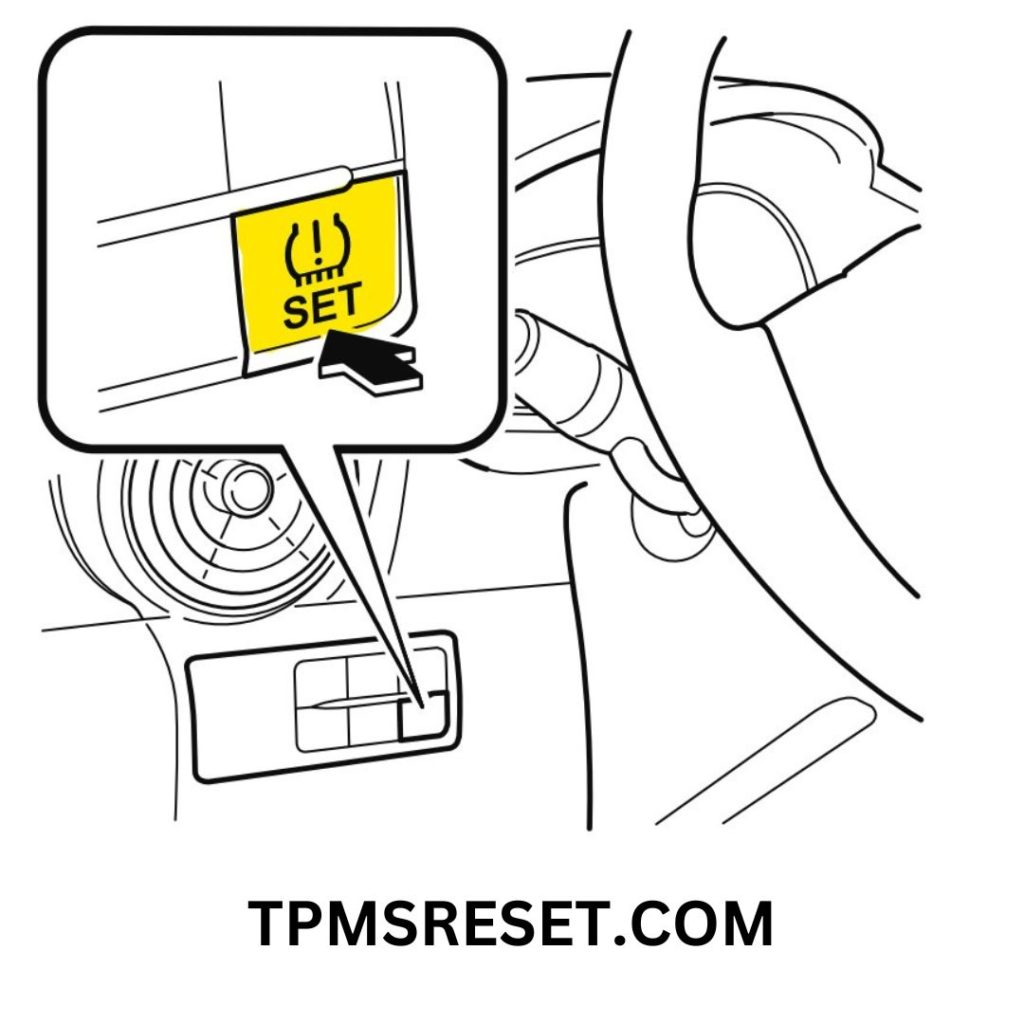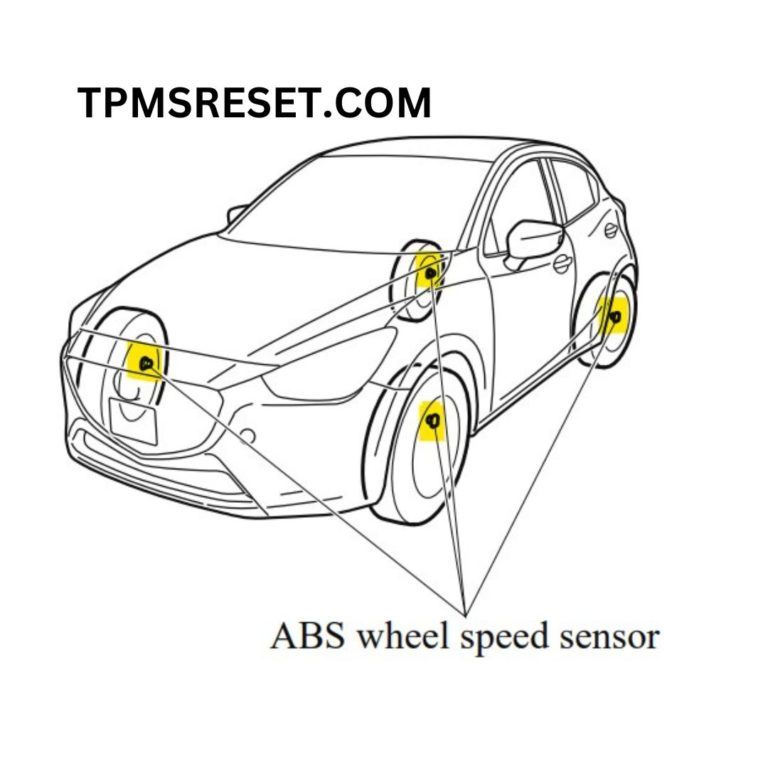Mazda2 Tire Pressure Monitoring System Description
In the Mazda2, there’s this cool feature called the tire pressure monitoring system (TPMS). Imagine it as your car’s way of giving you a head’s up when your tires need some attention. This system is all about keeping you in the loop on your tire pressure. If something’s not quite right, it lets you know. This way, you can be sure your Mazda2 is riding on well inflated tires, keeping you and your car in harmony on the road.
How Does the Mazda2 TPMS Work?
The 2015 – present Mazda2 does not use individual tire pressure sensors. Instead it uses the vehicle’s ABS wheel speed sensors to measure tire pressure. Here is how it works:
Utilizes ABS sensors: The system takes advantage of the car’s Anti-lock Braking System (ABS) sensors, which are already in place to monitor tire rotation speed for braking purposes. (They are mounted behind each wheel.)
Analyzes tire speed differences: The indirect TPMS continuously compares the rotation speed of all four tires, keeping an eye out for any discrepancies that might suggest a change in tire pressure.
Importance of calibration: To maintain accuracy, the system needs to be calibrated occasionally, particularly after adjusting tire pressure, rotating tires, or replacing them. This process helps the system recognize the “normal” tire rotation speed for your Mazda2. Scroll down to see all of the times you should recalibrate your tire pressure system.
Dashboard warning light: When the system detects a significant difference in tire rotation speed, usually due to low or high tire pressure, it activates a warning light on the dashboard to inform the driver about the potential issue.
No direct pressure measurements: Keep in mind that the indirect TPMS doesn’t measure actual tire pressure values like a direct TPMS would. Instead, it relies on rotation speed variations to identify potential pressure problems.
How to Reset Mazda2 Tire Pressure Light:
Make sure the tire pressures in all four tires are correct as specified on the tire placard.
Turn the ignition switch to the “ON” position.
Press and hold the tire pressure monitoring system (TPMS) button until the TPMS indicator light in the instrument cluster flashes twice. (found on the left of the steering wheel)
Release the TPMS button. The TPMS indicator light should turn off.
Drive the vehicle at speeds above 16 mph (25 km/h) for at least 10 minutes.
TIP: If the tire pressure light won’t go off after following these steps, double check your air pressure manually with a tire gauge and then repeat the reset procedure. (tire pressure gauge we recommend below)
Malfunctioning Tire Pressure Monitoring System
Your car comes with a nifty TPMS malfunction indicator to let you know when the system isn’t working as it should. This indicator is combined with the low tire pressure warning light. (It’s a separate feature from regular tire pressure monitoring but uses the same light on the dashboard) If there’s a problem with the TPMS, the warning light will flash for about a minute and then stay on constantly. This pattern will repeat every time you start your car until the issue is fixed. Keep in mind that when this indicator is on, the system might not be able to alert you to low tire pressure properly. TPMS issues can happen for various reasons, such as installing different tires or wheels that interfere with the system’s functionality or a faulty wheel speed sensor. Make sure to always check the TPMS malfunction indicator after changing any tires or wheels on your vehicle to ensure everything is working smoothly.
What Will Cause the Mazda2 Tire Light to Turn On?
Low tire pressure: One or more tires have significantly lower pressure than recommended.
High tire pressure: One or more tires are overinflated beyond the recommended pressure.
Uneven tire wear: Excessive or uneven tire tread wear on one or more tires can affect their rotation speed.
Tire rotation: The TPMS may need recalibration after tires have been rotated.
Tire replacement: New tires with different characteristics may require the system to be recalibrated.
Mismatched tire sizes: Using different tire sizes on the same axle can cause discrepancies in rotation speed. Always replace tires with OEM size tires to prevent these issues.
Damaged wheel or tire: Damage, such as a bent or cracked wheel or a tire with a bulge, can impact rotation speed.
Malfunctioning ABS sensor: An issue with the Anti-lock Braking System sensor may affect the TPMS’s ability to monitor tire rotation speed. Faulty ABS or wheel speed sensors.
System malfunction: The TPMS itself may be experiencing a malfunction or failure that needs to be addressed by a professional.
What Happens When Tires are Underinflated?
When your Mazda2 tires are underinflated, it can lead to some undesirable consequences. First off the ride quality takes a hit, making your driving experience less smooth and comfortable. More importantly, underinflated tires can negatively impact fuel efficiency, as they create extra resistance and force your car to work harder. In addition, they will wear out unevenly and much faster, shortening their lifespan. Worst of all, underinflated tires can compromise your safety, as they affect handling, traction, and braking, all increasing the risk of accidents. So always make sure your Mazda2’s tires are properly inflated to keep your car performing at its best and to ensure a safe driving experience.
When to Recalibrate the Mazda2 TPMS:
After inflating or adjusting tire pressure
After tire rotations
After replacing tires
After wheel alignments
After wheel balances
After seasonal temperature changes
After repairing or replacing a faulty ABS or wheel speed sensor
If the TPMS warning light stays on despite resolving tire pressure issues
Manufacturer’s recommendation
After jumping or replacing the vehicle battery
After any suspension work
TIP: Be sure to check all tire pressures before recalibrating the tire pressure system regardless of the reason or cause.
How the Weather Affects Tire Pressure
For every 10 degrees change in weather temperature, tire pressure can fluctuate by about 1 psi. For example, if the temperature goes from 80 degrees fahrenheit to 50 degrees fahrenheit, your tire pressure will drop about 3 PSI.
The chart above illustrates the relationship between temperature and tire pressure changes in both Fahrenheit and Celsius, as well as PSI and kPa units. It demonstrates that as the temperature decreases, tire pressure drops accordingly, while the opposite occurs when the temperature increases. The baseline temperature for checking tire pressure is considered to be around 62°F (16.7°C), where no significant tire pressure changes are observed. The chart serves as a helpful guide for understanding how temperature fluctuations can affect tire pressure. Emphasizing the importance of regularly checking and adjusting tire pressure, especially during extreme weather conditions.
Mazda2 Tire Maintenance
Adjusting the tire pressure of your Mazda2 when the tires are cold is crucial for basic tire maintenance. You see, as you drive, the friction between the tires and the road generates heat, causing the air inside the tires to expand and the pressure to increase. Checking and adjusting tire pressure when they’re cold ensures that you’re setting it to the most accurate baseline value, as recommended by the manufacturer. (it even says so on the sticker in your door-jamb) This way, you can maintain optimal performance, safety, and fuel efficiency while you’re on the road. So, make it a habit to give your Mazda2 tires some love with a cold pressure check and adjustment. We recommend checking pressures at least once a month and before any trips!



